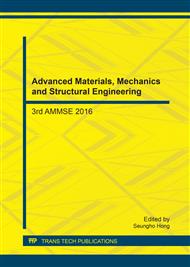p.44
p.48
p.53
p.59
p.64
p.71
p.78
p.84
p.89
The Effect of Waterproof Processing Method on Properties of Calcium Silicate Board
Abstract:
In this paper, the effect of waterproof processing method on properties of calcium silicate board was studied in view of the requirement of calcium silicate board for building external wall. Experiments adopted waterborne epoxy resin in the test to do waterproof processing by three ways, which means taking the measure of waterproof processing respectively on two surfaces of the sample, on two surfaces and two lateral faces of the sample, and on all the six surfaces of the sample. The results showed that the sample could easily get wet from the side to the center, and it could only get satisfactory results when taking waterproof processing on all the six surfaces of the sample. Meanwhile, the water absorption rate of the sample decreased from 18.4% to 4.4% and its bending strength significantly got improved even after that the sample was treated separately by freeze-thaw cycles, dry-wet circulation, and soaking in hot water. Moreover, the performance of moisture deformation of the sample got reduced.
Info:
Periodical:
Pages:
64-70
Citation:
Online since:
February 2017
Authors:
Price:
Сopyright:
© 2017 Trans Tech Publications Ltd. All Rights Reserved
Share:
Citation:


